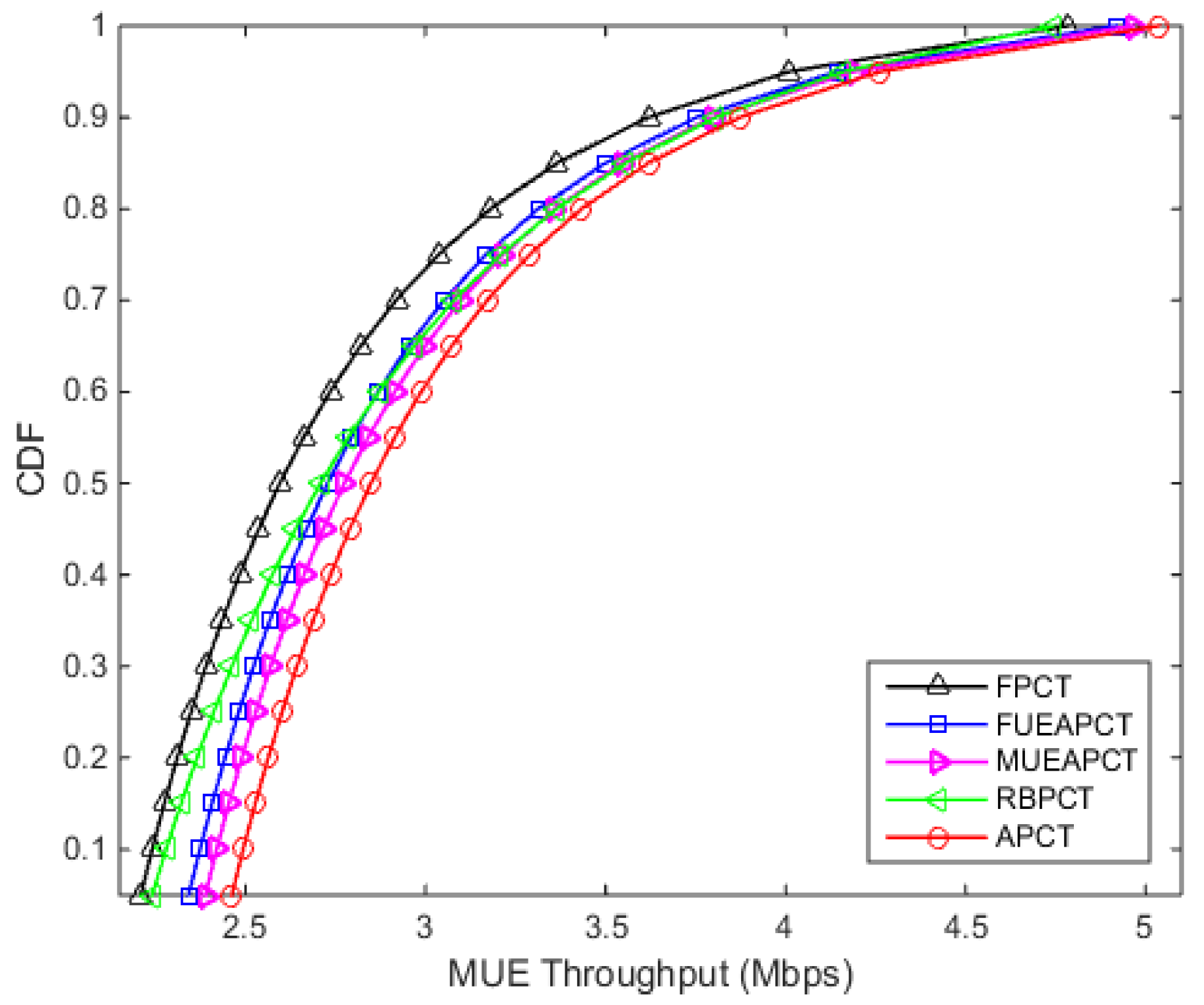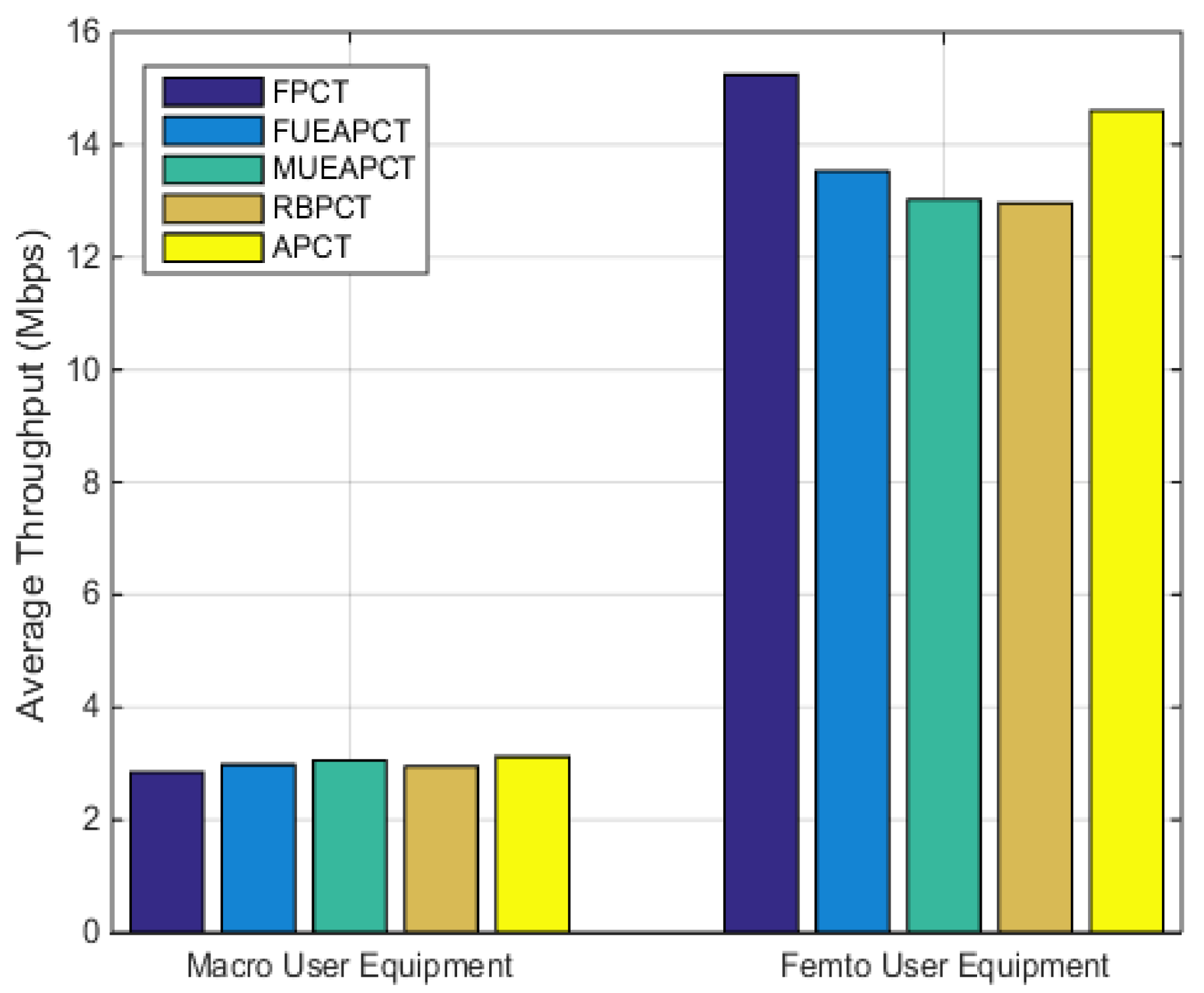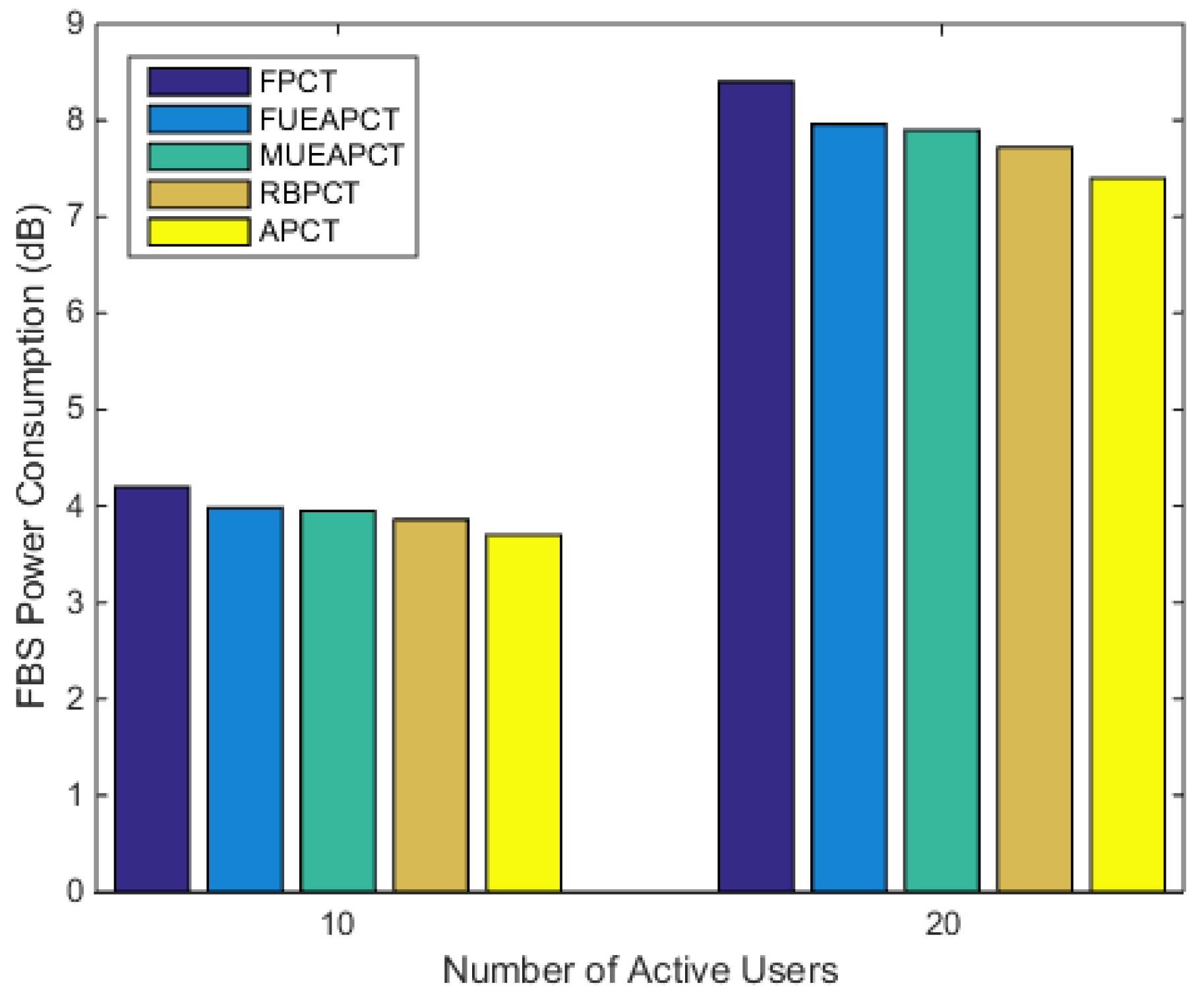An Active Power Control Technique for Downlink Interference Management in a Two-Tier Macro–Femto Network
Abstract
1. Introduction
2. Related Work
3. System Model
3.1. Pathloss Model
3.2. Spectral Efficiency
4. Power Control Techniques
4.1. Power Control Technique Assisted by FUE
4.2. Power Control Technique Assisted by MUE
4.3. Range-Based Power Control Technique (RBPCT)
5. Proposed Active Power Control Technique
- The Active Power Control Technique effectively reduces the inter-cell interference and optimize the throughput performance of the MUE.
- The proposed technique not only reduces ICI to MUE but also maintains the QoS of FUE by considering the RSRP (Reference Signal Received Power) feedback from the Femto user to adjust its downlink transmission power.
- The femtocell actively tunes its downlink power by using the power levels (, and ) and time levels ( and ), Hence, the proposed APC approach reduce the unnecessary power consumption to achieve green femtocell network.
- Compared with existing power control approaches, the proposed approach offers significantly better performance in terms of downlink throughput CDF of the macro user and the femto user, the average throughput, FBS Power consumption and the green impact and CO emission.
6. Simulation Results and Discussion
6.1. Analyzing Downlink Throughput Distribution
6.2. Average Throughput
6.3. FBS Power Consumption
6.4. Green Impact and CO Emission
7. Conclusions
Author Contributions
Funding
Acknowledgments
Conflicts of Interest
References
- Xu, Y.; Hu, Y.; Li, G. Robust Rate Maximization for Heterogeneous Wireless Networks under Channel Uncertainties. Sensors 2018, 18, 639. [Google Scholar] [CrossRef] [PubMed]
- Wang, H.; Zhu, C.; Ding, Z. Femtocell Power Control for Interference Management Based on Macrolayer Feedback. IEEE Trans. Veh. Technol. 2016, 65, 5222–5236. [Google Scholar] [CrossRef]
- Leanh, T.; Tran, N.H.; Lee, S.; Huh, E.N.; Han, Z.; Hong, C.S. Distributed Power and Channel Allocation for Cognitive Femtocell Network Using a Coalitional Game in Partition-Form Approach. IEEE Trans. Veh. Technol 2017, 66, 3475–3490. [Google Scholar] [CrossRef]
- Yuan, H.; Ma, J.; Yang, H.; Liu, Z.; Guan, X. Robust power allocation and price-based interference management in two-tier femtocell networks. In Proceedings of the Chinese Control Conference, Hangzhou, China, 28–30 July 2015; pp. 6483–6488. [Google Scholar]
- Qutqut, M.H.; Al-Turjman, F.M.; Hassanein, H.S. MFW: Mobile femtocells utilizing WiFi: A data offloading framework for cellular networks using mobile femtocells. In Proceedings of the 2013 IEEE International Conference on Communications (ICC), Budapest, Hungary, 9–13 June 2013; pp. 6427–6431. [Google Scholar]
- Chowdhury, M.Z.; Jang, Y.M.; Haas, Z.J. Network Evolution and QOS Provisioning For Integrated Femtocell/Macrocell Networks. Int. J. Wirel. Mob. Netw. 2010, 2, 1–16. [Google Scholar] [CrossRef]
- Mar, J.; Chang, T.; Wang, Y. A Quadrilateral Geometry Classification Method and Device for Femtocell Positioning Networks. Sensors 2017, 17, 817. [Google Scholar] [CrossRef]
- Bouras, C.; Diles, G.; Kokkinos, V.; Papazois, A. Femtocells coordination in future hybrid access deployments. In Proceedings of the 2014 11th International Symposium on Wireless Communications Systems (ISWCS), Barcelona, Spain, 26–29 August 2014; pp. 313–317. [Google Scholar]
- Lee, Y.L.; Loo, J.; Chuah, T.C. Dynamic Resource Management for LTE-Based Hybrid Access Femtocell Systems. IEEE Syst. J. 2018, 12, 959–970. [Google Scholar] [CrossRef]
- Bao, N.K.; Joung, S.; Park, M. A new access mode for femtocells in 5G networks. In Proceedings of the 2015 International Conference on Information and Communication Technology Convergence (ICTC), Jeju, Korea, 28–30 October 2015; pp. 1368–1370. [Google Scholar]
- De la Roche, G.; Valcarce, A.; Lopez-Perez, D.; Zhang, J. Access control mechanisms for femtocells. IEEE Commun. Mag. 2010, 48, 33–39. [Google Scholar] [CrossRef]
- Mehta, M.; Rane, N.; Karandikar, A.; Imran, M.A.; Evans, B.G. A self-organized resource allocation scheme for heterogeneous macro-femto networks. Wirel. Commun. Mob. Comput. 2016, 16, 330–342. [Google Scholar] [CrossRef]
- Al-Turjman, F. Small Cells in the Forthcoming 5G IoT: Traffic Modeling and Deployment Overview. IEEE Commun. Surv. Tutor. 2019, 21, 28–65. [Google Scholar] [CrossRef]
- Lee, J.Y.; Bae, S.J.; Kwon, Y.M.; Chung, M.Y. Interference analysis for femtocell deployment in OFDMA systems based on fractional frequency reuse. IEEE Commun. Lett. 2011, 15, 425–427. [Google Scholar]
- Patil, R.; Patane, R.D. Inter-cell Interference Mitigation Reduction in LTE Using Frequency Reuse Scheme. Int. J. Sci. Res. Publ. 2015, 5, 1–5. [Google Scholar]
- CEET White Paper, Bell Labs and University of Melbourne (2013), The Power of Wireless Cloud: An Analysis of the Energy Consumption of Wireless Cloud–CEET. Available online: https://ceet.unimelb.edu.au/publications/ceet-white-paper-wireless-cloud.pdf (accessed on 28 April 2019).
- Al-Turjman, F. Modeling Green Femtocells in Smart Grids. Mob. Netw. Appl. 2018, 23, 940–955. [Google Scholar] [CrossRef]
- Tian, R.; Ma, L.; Wang, Z.; Tan, X. Cognitive Interference Alignment Schemes for IoT Oriented Heterogeneous Two-Tier Networks. Sensors 2018, 18, 2548. [Google Scholar] [CrossRef]
- Al-Turjman, F. 5G-enabled devices and smart-spaces in social-IoT: An overview. Future Gener. Comput. Syst. 2019, 92, 732–744. [Google Scholar] [CrossRef]
- Khan, F.H.; Choi, Y.J. Joint subcarrier and power allocations in OFDMA-based cognitive femtocell networks. In Proceedings of the APCC 2012—18th Asia-Pacific Conference Communication, Jeju, Korea, 15–17 October 2012; pp. 812–817. [Google Scholar]
- Zahir, T.; Arshad, K.; Ko, Y.; Moessner, K. A downlink power control scheme for interference avoidance in femtocells. In Proceedings of the IWCMC 2011—7th International Wireless Communication Mobile Computation Conference, Istanbul, Turkey, 4–8 July 2011; pp. 1222–1226. [Google Scholar]
- Su, X.; Liang, C.; Choi, D.; Choi, C. Power Allocation Scheme for Femto-to-Macro Downlink Interference Reduction for Smart Devices in Ambient Intelligence. Mob. Inf. Syst. 2016, 2016, 7172515. [Google Scholar] [CrossRef]
- Sun, D.; Zhu, X.; Zeng, Z.; Wan, S. Downlink power control in cognitive femtocell networks. In Proceedings of the International Conference on Wireless Communications and Signal Processing, Nanjing, China, 9–11 November 2011; pp. 1–5. [Google Scholar]
- Sharanya, R.; Gunasundari, R.; Jayanthi, K. Dynamic Power Tuning For Downlink Interference Mitigation In Heterogeneous LTE Network. ARPN J. Eng. Appl. Sci. 2015, 10, 1810–1814. [Google Scholar]
- Wang, Z.; Xiong, W.; Dong, C.; Wang, J.; Li, S. A novel downlink power control scheme in LTE heterogeneous network. In Proceedings of the 2011 International Conference on Computational Problem-Solving (ICCP), Chengdu, China, 21–23 October 2011; pp. 24–245. [Google Scholar]
- Tao, X.; Zhao, Z.; Li, R.; Palicot, J.; Zhang, H. Downlink interference minimization in cognitive LTE-femtocell networks. In Proceedings of the 2013 IEEE/CIC International Conference on Communications in China (ICCC), Xi’an, China, 12–14 August 2013; pp. 124–129. [Google Scholar]
- De Lima, C.H.M.; Bennis, M.; Latva-aho, M. Coordination Mechanisms for Self-Organizing Femtocells in Two-Tier Coexistence Scenarios. IEEE Trans. Wirel. Commun. 2012, 11, 2212–2223. [Google Scholar] [CrossRef]
- Saad, S.A.; Ismail, M.; Nordin, R.; Ahmed, A.U. A fractional path-loss compensation based power control technique for interference mitigation in LTE-A femtocell networks. Phys. Commun. 2016, 21, 1–9. [Google Scholar] [CrossRef]
- Saad, H.; Mohamed, A.; ElBatt, T. Distributed Cooperative Q-Learning for Power Allocation in Cognitive Femtocell Networks. In Proceedings of the 2012 IEEE Vehicular Technology Conference (VTC Fall), Quebec City, QC, Canada, 3–6 September 2012; pp. 1–5. [Google Scholar]
- Interference control for LTE Rel-9 HeNB cells. In Proceedings of the 3GPP TSG RAN WG4 #53 R4-094245, Jeju, Korea, 9–13 November 2009.
- Technical Specification Group Radio Access Network (E-UTRA); Further Advancements for E-UTRA Physical Layer Aspects (Release 9); 3GPP TR 36.814 V9.0.0 (2010-03); 3GPP: Sophia Antipolis, France, 2010.
- LTE Evolved Universal Terrestrial Radio Access (E-UTRA); Radio Frequency (RF) System Scenarios (3GPP TR 36.942 Version 11.0.0 Release 11); ETSI TR 136.942 V11.0.0 (2012-10); 3GPP: Sophia Antipolis, France, 2012.
- Burr, A.; Papadogiannis, A.; Jiang, T. MIMO truncated Shannon bound for system level capacity evaluation of wireless networks. In Proceedings of the 2012 IEEE Wireless Communications and Networking Conference, Paris, France, 1 April 2012; pp. 268–272. [Google Scholar]
- Zheng, Z.; Dowhuszko, A.A.; Hämäläinen, J. Interference management for LTE-Advanced Het-Nets: Stochastic scheduling approach in frequency domain. Trans. Emerging Telecommun. Technol. 2012, 24, 4–17. [Google Scholar] [CrossRef]
- Further Discussion on HeNB Downlink Power Setting in HetNet. In Proceedings of the 3GPP TSG-RAN WG1 Meeting #63 R1-106009, Jacksonville, FL, USA, 15–19 November 2010.
- Alotaibi, S.; Akl, R. Range-Based Scheme for Adjusting Transmission Power of Femtocell in Co-Channel Deployment. Int. J. Interdisciplin. Telecommun. Netw. 2018, 10, 14–24. [Google Scholar]
- Hassan, T.U.; Gao, F.; Jalal, B.; Arif, S. Interference management in femtocells by the adaptive network sensing power control technique. Future Internet 2018, 10, 25. [Google Scholar] [CrossRef]
- Simulation assumptions and parameters for FDD HeNB RF requirements. In Proceedings of the 3GPP TSG RAN WG4 (Radio) Meeting #51 R4-092042, San Francisco, CA, USA, 4–8 May 2009.
- Piro, G.; Miozzo, M.; Forte, G.; Baldo, N.; Grieco, L.A.; Boggia, G.; Dini, P. HetNets Powered by Renewable Energy Sources: Sustainable Next-Generation Cellular Networks. IEEE Internet Comput. 2013, 17, 32–39. [Google Scholar] [CrossRef]
- Auer, G.; Giannini, V.; Desset, C.; Godor, I.; Skillermark, P.; Olsson, M.; Imran, M.; Sabella, D.; Gonzalez, M.; Blume, O.; et al. How much energy is needed to run a wireless network? IEEE Wirel. Commun. 2011, 18, 40–49. [Google Scholar] [CrossRef]
- Belkhir, L.; Elmeligi, A. Assessing ICT global emissions footprint: Trends to 2040 & recommendations. J. Clean. Prod. 2018, 177, 448–463. [Google Scholar]






| Input | Interference Messages and FUE Feedback Report. |
|---|---|
| Output | Downlink Transmission Power Tuning. |
| step 1 | Using (10), the macro user decides to send IM including HeNB information to eNB. |
| step 2 | HeNB instruct its users to send a feedback report. Based on the (16), which indicates the minimum required QoS, the FUE send the information to HeNB. |
| step 3 | Based on the IM from the MUE and QoS indication report from the FUE, HeNB actively tune its downlink transmission power using (17) |
| Parameters | Assumptions |
|---|---|
| Carrier frequency | 2 GHz |
| Transmit power of macrocell | 43 dBm |
| HeNB Noise Figure | 8 dB |
| Femtocell’s Transmit Power | Bm and dBm |
| Lognormal shadowing standard deviation for Femtocell | 4 dB |
| Macrocell coverage Area | 500 m |
| Shadowing standard deviation for Macrocell | 8 dB |
| Femtocell Coverage Area | 25 m |
| Exterior wall penetration loss | 5 dB |
| Interior penetration loss () | 15 dB |
| Thermal Noise Density () | −174 dBm/Hz |
| Bandwidth | 10 MHz |
| Macrocell antenna Gain | 14 dBi |
| Access Mode | |
| Interference threshold, | −72 dBm |
| Minimum separation UE to HeNB | m |
| Minimum separation UE to eNB | 35 m |
| and | 200 ms |
| 2 dB | |
| Traffic Model | Full Buffer |
| Minimum required SINR for FUE () | 10 dB |
| Power Control Techniques | Power Saving (%) | CO Saving (kg/year) |
|---|---|---|
| FUE Assisted Power Control Technique | 7.5 | |
| MUE Assisted Power Control Technique | 6.39 | |
| Range Based Power Control Technique | 4.9 | |
| Proposed Active Power Control Technique | 13.51 |
© 2019 by the authors. Licensee MDPI, Basel, Switzerland. This article is an open access article distributed under the terms and conditions of the Creative Commons Attribution (CC BY) license (http://creativecommons.org/licenses/by/4.0/).
Share and Cite
Hassan, T.U.; Gao, F. An Active Power Control Technique for Downlink Interference Management in a Two-Tier Macro–Femto Network. Sensors 2019, 19, 2015. https://doi.org/10.3390/s19092015
Hassan TU, Gao F. An Active Power Control Technique for Downlink Interference Management in a Two-Tier Macro–Femto Network. Sensors. 2019; 19(9):2015. https://doi.org/10.3390/s19092015
Chicago/Turabian StyleHassan, Tehseen Ul, and Fei Gao. 2019. "An Active Power Control Technique for Downlink Interference Management in a Two-Tier Macro–Femto Network" Sensors 19, no. 9: 2015. https://doi.org/10.3390/s19092015
APA StyleHassan, T. U., & Gao, F. (2019). An Active Power Control Technique for Downlink Interference Management in a Two-Tier Macro–Femto Network. Sensors, 19(9), 2015. https://doi.org/10.3390/s19092015




